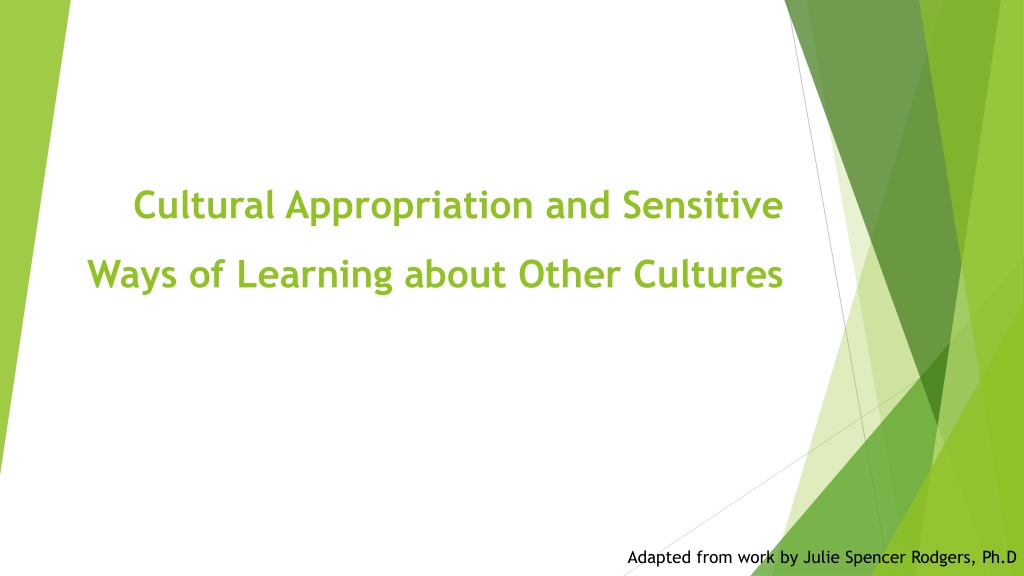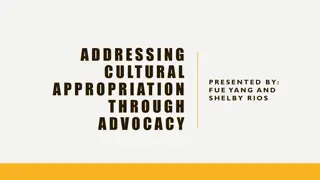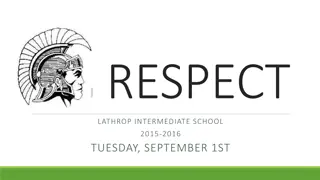Understanding Cultural Appropriation and Respectful Cultural Learning
This content delves into the concept of cultural appropriation, offering definitions, examples, and ways to avoid it. It emphasizes the importance of cultural appreciation and outlines the differences between appropriation and appreciation, highlighting the power dynamics involved. Readers gain insights into the impact of appropriation on marginalized groups and learn how to engage in cultural exchange respectfully.
Download Presentation

Please find below an Image/Link to download the presentation.
The content on the website is provided AS IS for your information and personal use only. It may not be sold, licensed, or shared on other websites without obtaining consent from the author. Download presentation by click this link. If you encounter any issues during the download, it is possible that the publisher has removed the file from their server.
E N D
Presentation Transcript
Cultural Appropriation and Sensitive Ways of Learning about Other Cultures Adapted from work by Julie Spencer Rodgers, Ph.D
Overview Definitions and terminology Examples of Cultural Appropriation on College Campuses (you may use images that pertain to your field of study. Be cautious when selecting images and be mindful that some images may offend members of minority cultures in your classroom.) Reasons why Cultural Appropriation Perpetuates Racism Psychological Effects of Cultural Appropriation How to Avoid Cultural Appropriation Adapted from work by Julie Spencer Rodgers, Ph.D
Cultural Appropriation on College Campuses Adapted from work by Julie Spencer Rodgers, Ph.D
Cultural Appropriation on College Campuses Adapted from work by Julie Spencer Rodgers, Ph.D
Definitions and Terminology Cultural Appropriation: The act of taking or using things from a culture that is not your own, especially without showing that you understand or respect this culture Involves a power dynamic in which members of a dominant group take cultural elements from an oppressed group that they themselves have dominated Cultural Exchange: Occurs when cultural groups share knowledge, technology, customs, etc. However Lacks a power dynamic Implies that all groups involved are equal Adapted from work by Julie Spencer Rodgers, Ph.D
Definitions and Terminology Cultural Assimilation: When a minority culture adopts the cultural elements, ideologies, and practices of a dominant culture Assimilation takes place when members of a marginalized group lose elements of their own culture and are absorbed into the culture of the dominant group For example, it is not cultural appropriation when a Mexican immigrant learns to speak English Cultural Appreciation: Learning about the customs and practices in a culture in a way that respects the culture Adapted from work by Julie Spencer Rodgers, Ph.D
The Main Difference Between Appropriation and Appreciation is Power For example, it is not cultural appropriation to use common objects such as paper (which was invented by the Chinese) because it is not a product of cultural exploitation and oppression It would not be cultural appropriation for a non-Japanese person to wear a Japanese kimono to a traditional wedding in Japan, but it would be cultural appropriation to wear one to a high school prom in the US You may include a video clip here YouTube video on the 7 Myths about cultural appropriation https://www.youtube.com/watch?v=KXejDhRGOuI Adapted from work by Julie Spencer Rodgers, Ph.D
In Your Field Provide examples of cultural appropriation in your field of study or work environment Adapted from work by Julie Spencer Rodgers, Ph.D
Reasons Why Cultural Appropriation Perpetuates Racism 1. It ignores the violent history of oppression The elements of culture that are adopted are usually taken from a cultural group that is economically and historically disadvantaged For example, Native American sports mascots (Washington Redskins) ignore the historical significance of the oppression of these groups 2. It allows one to love elements of the minority culture, but disregard it s people For example, Caucasian celebrities wear cornrows as a cool fashion statement but at the same time African Americans are criticized for wearing them to work. Adapted from work by Julie Spencer Rodgers, Ph.D
Reasons Why Cultural Appropriation Perpetuates Racism 3. It erases origin and allows dominate groups to take credit for things they didn t create For example, country music was actually born out of the Antebellum South, where instruments like banjos, fiddles, and harmonicas were the instruments of choice among African-Americans 4. It allows dominant groups to profit from oppressed groups For example, the fashion industry uses Native American cultural elements to sell lingerie 5. It perpetuates stereotypes and misrepresents the culture Adapted from work by Julie Spencer Rodgers, Ph.D
Psychological Effects of Cultural Appropriation Research studies show that cultural appropriation negatively affects members of minority cultures (Fryberg, Markus, Oyserman, and Stone, 2008) Participants and procedure: American Indian high school students (n=71) residing on an Indian reservation Image of Chief Wahoo, mascot of the Cleveland Indians major league baseball team Students were presented with either: images of Chief Wahoo images of Pocohantas information regarding stereotypically negative outcomes among Indian youth (e.g., 50% to 55% of American Indian high school students drop out of high school) control condition image Later, students completed a questionnaire that included a measure of self esteem Adapted from work by Julie Spencer Rodgers, Ph.D
Self-Esteem Scores (1-5 scale) Adapted from work by Julie Spencer Rodgers, Ph.D
Psychological Effects of Cultural Appropriation Results: Participants self-esteem was lowest after viewing the image of Chief Wahoo sports mascot Importantly, their self-esteem scores were even lower than those students who read about the high rates of depression, suicide, and alcoholism among Indian youth Adapted from work by Julie Spencer Rodgers, Ph.D
How to Avoid Cultural Appropriation Ask yourself the 3 S s 1. Source: Who are you borrowing or buying from? The closer to the original source, the less likely you are appropriating 2. Significance: Is the cultural object (or thing for sale) of great significance in its source community, such as a Native American Headdress, or is it something meant to be used on a daily basis? 3. Similarity: Is the cultural object (or thing for sale) a direct copy of an object of cultural heritage, or is it inspired by it, only including a slight resemblance? - For example, a Victoria s Secret Native American piece of lingerie Adapted from work by Julie Spencer Rodgers, Ph.D
How to Avoid Cultural Appropriation Context Consider the context. Is the cultural group you are borrowing from a minority, historically disadvantaged, or oppressed group? Benefit How do you benefit from borrowing from the cultural group? For example, are you selling a product? Adapted from work by Julie Spencer Rodgers, Ph.D
Summary Cultural appropriation has a negative effect on members of minority cultures Consider the impact of your actions, not just your intentions Learn about ways to avoid cultural appropriation Celebrate diversity, and learn about the norms and practices of minority cultures Classroom activities and debates (see resource list) Adapted from work by Julie Spencer Rodgers, Ph.D























